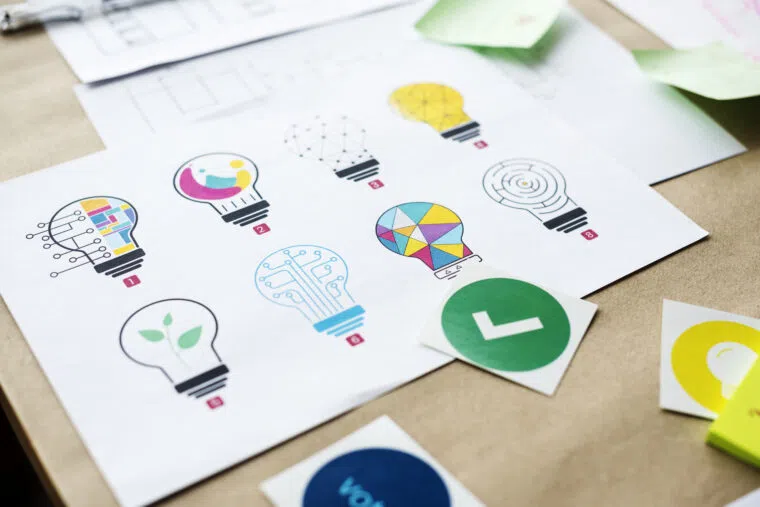What is Design Thinking? How Important is it for Success?

- What is Design Thinking?
- Design Thinking Examples
- Importance of Design Thinking
- Principles of Design Thinking
- 5 Stages of the Design Thinking Process
- Ways to Get Started with Design Thinking
- What is the Relationship Between Design Thinking and UX Design?
- What can Design Thinking do for Your Business?
A couple of decades have passed since design thinking emerged as a significant influence in the commercial sector. It is used by companies such as Apple, Procter & Gamble (P&G), Coca-Cola, and Intuit, among others, to build products around consumer needs. These businesses have demonstrated that one of the best ways to encourage innovation is to make it an integral part of corporate strategy and then implement it throughout the entire organization. So, what is design thinking? And how important is it for a company? Let’s dive in.
What is Design Thinking?
It refers to the collection of cognitive, strategic, and practical techniques employed by designers. They use information gained about consumer needs and behaviors to inform their planning and strategy.
Design thinking is “human-centered”. This implies that it makes use of data on real customer (human) interactions with a good or service as opposed to assumptions made by others or by an organization. To be really human-centered, designers must observe how users interact with a product or service and make adjustments to enhance the user experience. This is the iterative aspect: It encourages speedy prototyping and testing as opposed to protracted research or contemplation.
Design Thinking Examples
Here are some real life examples:
Airbnb
This article, “How Design Thinking Transformed Airbnb from a Failing Startup to a Billion Dollar Business,” from First Round Review describes how the renowned start-up moved from profits of $200 a week to the unicorn it became. The success of Airbnb is partly due to design thinking; where they placed the users at the core of their business. Upon realizing that the bookings were receding, the Airbnb team spoke to the hosts and found out that the lack of quality pictures on the listing was cause for concern. They came up with the solution to take pictures of all the properties in New York making bookings easier for both the hosts and the guests.
Uber Eats
The Uber Eats design team frequently uses design thinking techniques to combine cutting-edge technology with the archaic and essential act of eating. The Walkabout Program, a quarterly event when UberEats designers are dispatched to a city to learn about its transit infrastructure, delivery and restaurant business, and overall food culture, was put in place because they wanted to understand their users’ experiences.
Netflix
Netflix has continually benefited from design thinking to grow into an industry powerhouse. When the company first started, its primary rival, Blockbuster, needed users to travel to physical storefronts to rent DVDs, and later return them. By using a subscription model, Netflix removed that inconvenience by sending DVDs right to consumers’ homes. From streaming original content that was appreciated by audiences outside the prime time viewers, to renewed user interface that showed trailers and suggestions based on user preferences, Netflix has consistently used design thinking to upgrade their services.
Oral B
Oral B hired designers Sam Hecht and Kim Colin to assist with the redesign of their electric toothbrush. The firm asked for the addition of new features for electric toothbrush users. Hecht and Colin noted that many people found brushing to be a neurotic activity. Users didn’t desire extra functionality and, in many situations, believed it may make them stressed out. They instead suggested two alternatives that might enhance the user experience without introducing gimmicks. Making the toothbrush easy to charge was their first piece of advice, particularly for those who were traveling. Another was enabling toothbrushes to link to phones and deliver reminder messages, making it easier for consumers to buy replacement heads. Because they concentrated on what users wanted rather than what the company wanted to roll out, both proposals were successful.
Importance of Design Thinking
An important aspect of product design and innovation, its importance can be summed up by these five factors:
- Improved collaborations
- Better brainstorming
- Overcoming creative obstacles
- User-focused
- Prioritizing customer needs
Principles of Design Thinking
To understand what is design thinking, you need to know its principles. These are:
- Emphasizing empathy and user experience
- Collaboration
- Creating solutions and ideas
- Replication and experimentation
- Proactive participation
- Staying ready for failure
- Flexibility
5 Stages of the Design Thinking Process
The design thinking framework encourages innovative ideas and approaches that help designers produce user-friendly solutions that address specific problems. Here are the five stages of the process:
Empathy
Designers meet with actual people at this part of the design thinking technique to absorb their perspectives, surroundings, and introspections without prejudice.
Define
In this step, designers must clearly state the difficulty or issue that their design must address. A designer formulates the problem statement after empathizing with and incorporating research-based expertise into the current human-centric challenge.
Ideation
The ideation phase mainly relies on inventiveness. Designers who successfully portray the human experience during the empathy stage then set out to provide original ideas for resolving the specified issue.
Prototype
The objective is to identify any obstacles related to bringing the invention to full life. Prototyping should ideally reveal more user experience issues and provide designers with a greater understanding of user actions, emotions, and expectations.
Test
The process testing phase necessitates the collection of real data from actual users. However, the final phase is not always the last action taken by designers.
Ways to Get Started with Design Thinking
Now that we’ve understood what is design thinking, here is how you can get started:
- Increase empathy
- Consult subject matter experts
- Create spaces for co-creation
- Verify that you are posing the appropriate queries
- Include it in your agile processes
- Empower engineers and designers to make strategic decisions
- Prepare to move features from the product
- Learn by doing
- Stay flexible
What is the Relationship Between Design Thinking and UX Design?
UX design concentrates on developing better goods and services, whereas design thinking is first perceived as management advice for creatives. While UX design is generally tactical and build-oriented, design thinking can be considered strategic and intellectual.
What can Design Thinking do for Your Business?
- Create a future-oriented road map
- Identify the right problem
- Build team collaboration and innovation
- Allow comprehensive knowledge of customers
- Keep up with the competition
- Increase your opportunities
- Add confidence to meetings
- Enhance the client experience
- Enable interactions in sales
According to the Design Management Institute, design-driven businesses have outperformed the S&P Index by 219% over the past 10 years. By prioritizing their consumers, design-driven businesses are succeeding as CEOs and senior executives are now influencing corporate choices using design thinking. You too can specialize by exploring the product design and innovation online courses offered by Emeritus.
By Siddhesh Shinde
Write to us at content@emeritus.org





